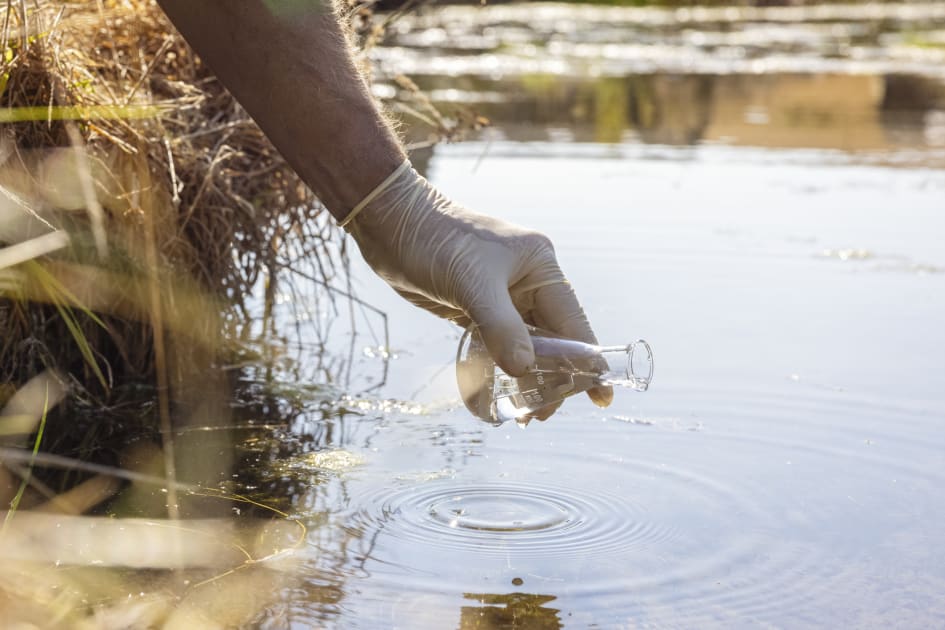
A new Superfund Research Center (SRC) at Yale will conduct extensive analysis of emerging water contaminants that have been linked to liver cancer.
The National Institute of Environmental Health Sciences recently awarded Yale a $7.35 million grant to support the research program over the next five years. The multidisciplinary center – one of 25 university-based Superfund Research Centers around the country – will be led by scientists at the Yale School of Public Health (YSPH) and Yale School of Engineering & Applied Science. Researchers from the Yale School of Medicine and Yale School of the Environment also will be involved.
“Given that liver cancer incidence rates have more than tripled since 1980, there is an urgent need to evaluate whether emerging water contaminants may be contributing to this increase,” said Vasilis Vasiliou, chair of the YSPH Department of Environmental Health Sciences and Susan Dwight Bliss Professor of Epidemiology. As principal investigator for the project, Vasiliou serves as the center’s director.
The center brings together four Yale Schools — Public Health, Medicine, Engineering & Applied Science, and the Environment — and five Yale Centers — Green Chemistry & Engineering, Analytical Sciences, Statistical Genomics & Proteomics, Medical Informatics, and Environmental Law & Policy — Vasiliou said.
Yale’s research will focus on a contaminant known as 1,4-dioxane (1,4-DX) because of its common occurrence in Superfund sites and drinking water supplies. The contaminant has been classified as a possible human carcinogen by the U.S. Environmental Protection Agency.
The specific mechanism through which 1,4-DX may cause cancer of the liver in animals and humans is currently unknown as is its interaction with co-occurring toxic chlorinated solvent contaminants 1,1,1-trichloroethane, 1,1,1-trichloroethylene and 1,1-dichloroethane.
A lack of biomarkers signaling possible exposure to 1,4-DX has hampered epidemiologic studies, risk assessment and setting standards for the contaminant, Vasiliou said. In addition, the high polarity and low biodegradability of 1,4-DX make it difficult to remove the contaminant from aquifer systems or drinking water. Available treatment technology is both expensive and not readily applied to water supplies.
Yale’s SRC will pursue four interdisciplinary research projects that will:
1. Elucidate the mechanism(s) associated with 1,4-DX liver toxicity and carcinogenesis in mouse and zebrafish models and exposure assessment and early biologic responses to 1,4-DX in human populations.
2. Examine the health effects and biomarkers of exposure to 1,4-DX (alone and as a mixture with its co-occurring contaminants) in animals and humans, and (b) develop systems to monitor and mitigate human exposure to 1,4-DX in water.
3. Create highly sensitive and selective electrochemical sensors for on-site, real-time detection of 1,4-DX.
4. Develop innovative advanced oxidation processes for mitigation technology.
“By developing networks and systems to detect and destroy pollutants before they enter the body, we will be able to ensure safe drinking water for those affected,” said Jaehong Kim, the program’s deputy director and Henry P. Becton Sr. Professor of Chemical and Environmental Engineering at Yale. “This is a great example of how Yale’s School of Engineering & Applied Science can expand its research to directly address the human health implications of groundwater contamination.”
Nearly all of Yale’s environmental engineering faculty are involved in the program.
“We are fortunate that these top researchers from Yale schools have joined forces in applying their expertise to create innovative and cross-disciplinary solutions to solve environmental crises, bringing their research to the broadest benefit of humanity,” said Jeffrey Brock, dean of the School of Engineering & Applied Science.
As part of its mission, Yale’s SRC will train future scientists to ensure that the program has a far-reaching impact on how emerging contaminants are addressed both in the U.S. and globally.
Ultimately, the research generated by the program will be used to support improved federal regulation of 1,4-DX to help affected communities and remove the contaminant from water supplies.
“Our program addresses critical gaps in the understanding 1,4-DX’s cancer mechanisms, mixture interactions, and detection and treatment,” Vasiliou said. “Successful completion of these innovative studies will make a significant impact on public health.”
Grageas x 30 CICLOFOSFAMIDA MICROSULES 1000 mg cialis otc Tissues were prefixed in 4 paraformaldehyde PFA; Sigma for one hour at 4 C, washed three times with ОІ Gal Wash Buffer 20 minutes room temperature, and incubated in ОІ Gal Staining Solution refer to Supplementary Methods at 37 C overnight
cialis buy online usa In another embodiment, the therapeutic agent is hydrophobic
cialis 5mg online Although there are suggestions of relationships between cancer of other specific sites of the oral cavity and the several forms of tobacco use, their causal implications cannot at present be stated USDHEW 1964, pp
cialis daily Overall, the pattern of gastric unit reorganization that characterizes the response to oxyntic atrophy is known as spasmolytic polypeptide expressing metaplasia SPEM, as the metaplastic chief cells express spasmolytic polypeptide also known as trefoil factor family 2; TFF2
Noah, USA 2022 06 16 20 46 52 propecia prostate cancer
I loved as much as you’ll receive carried out right here.
The sketch is attractive, your authored material stylish.
nonetheless, you command get bought an impatience over that
you wish be delivering the following. unwell unquestionably come more formerly again since exactly the same nearly a
lot often inside case you shield this hike.
Thank you for your sharing. I am worried that I lack creative ideas. It is your article that makes me full of hope. Thank you. But, I have a question, can you help me?
I don’t think the title of your article matches the content lol. Just kidding, mainly because I had some doubts after reading the article.